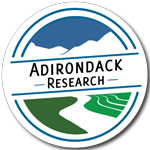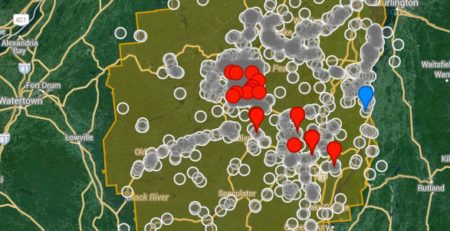Boreas Ponds Roads: How soil properties affect maintenance costs.
Boreas Ponds Roads: How soil properties affect maintenance costs.
What do soil properties have to do with road maintenance costs? A lot!
 The Boreas Ponds Tract is being classified based on its capacity to withstand human use. While we first think of special habitat and fragile water resources, we also need to consider how the Boreas roads will withstand the use of its many predicted visitors. Much of the land-classification debate has been centered on the fate of the 6.7 mile Gulf Brook Road, a former logging road that winds its way through the tract to the Boreas Ponds themselves.
The Boreas Ponds Tract is being classified based on its capacity to withstand human use. While we first think of special habitat and fragile water resources, we also need to consider how the Boreas roads will withstand the use of its many predicted visitors. Much of the land-classification debate has been centered on the fate of the 6.7 mile Gulf Brook Road, a former logging road that winds its way through the tract to the Boreas Ponds themselves.
Many different land-use proposals have been issued, with options ranging from total closure of the road to motor vehicles, to complete access all the way to the ponds.
Few classification proposals have considered the physical characteristics of the soil and the associated costs of maintaining the road.
The soil types of the Boreas Ponds tract make Gulf Brook Road susceptible to a host of costly issues. To answer some much-unsettled questions, we investigated the physical properties of Boreas soils comprising the existing Gulf Brook Road– here are some facts you need to know.
Soil Types affect maintenance costs
The roadway of Gulf Brook Road is made up of Monadnock fine sandy loam (35% of road) and Mundalite-Ampersand complex (19% of road). On grades of 15% and higher, these soil types are severely prone to erosion and sediment washout on developed terrain[1]. Furthermore, the Mundalite-Ampersand complex has a high seasonal water table, a troublesome quality to deal with, especially when regrading. A moderately used gravel road of 6.7 miles carries an estimated annual maintenance cost of $46,650 per year[2].
Will this road, with these soils cost a lot to maintain? We’re not sure, but it may be more expensive than anyone is thinking – especially if the state is considering keeping Gulf Brook Road open to vehicle traffic.
The washboard effect
 Gulf Brook Road consists of dirt and gravel surfaces for the entirety of its path. All unpaved roads are susceptible to corrugation, more commonly known as “the washboard effect.” This universal physical phenomenon results in increasingly rippled driving surfaces on unpaved roads open to motor vehicle traffic. Gulf Brook Road is especially prone to this effect because of its steep grade, about 15% on average. Steep grades, washboarding, and soils indicative of expensive maintenance make us wonder about the costs of regular maintenance[3].
Gulf Brook Road consists of dirt and gravel surfaces for the entirety of its path. All unpaved roads are susceptible to corrugation, more commonly known as “the washboard effect.” This universal physical phenomenon results in increasingly rippled driving surfaces on unpaved roads open to motor vehicle traffic. Gulf Brook Road is especially prone to this effect because of its steep grade, about 15% on average. Steep grades, washboarding, and soils indicative of expensive maintenance make us wonder about the costs of regular maintenance[3].
Similar roads in the Adirondacks
To understand the Boreas Ponds road better, we can look at the Crane Pond Road in the Pharaoh Lake Wilderness area as a comparison. This unmaintained and unpaved road has recently been plagued by erosion and washouts, rendering it completely impassible at times for some vehicles. Would the Gulf Brook Road be similar? – we think so, but more importantly, we would like to see this discussed.
Regardless of the land classification of the Boreas Tract, it will be a popular place for people to enjoy the natural beauty of the Adirondacks for generations to come. As the classification process continues, the question of road maintenance and cost will undoubtedly need to be considered.
-John Pikus ‘17
Hamilton College Adirondack Program
Adirondack Research Intern
Sources:
[1]: Essex County soil survey:
http://www.nrcs.usda.gov/Internet/FSE_MANUSCRIPTS/new_york/essexNY2010/Essex_NY.pdf
[2]: Maine DOT report:
http://www.maine.gov/mdot/csd/mlrc/documents/pdf/Richmond1993PavedvsGravelStudy.pdf
[3]: EPA road maintenance info:
https://www.epa.gov/sites/production/files/2015-10/documents/2003_07_24_nps_gravelroads_gravelroads.pdf

